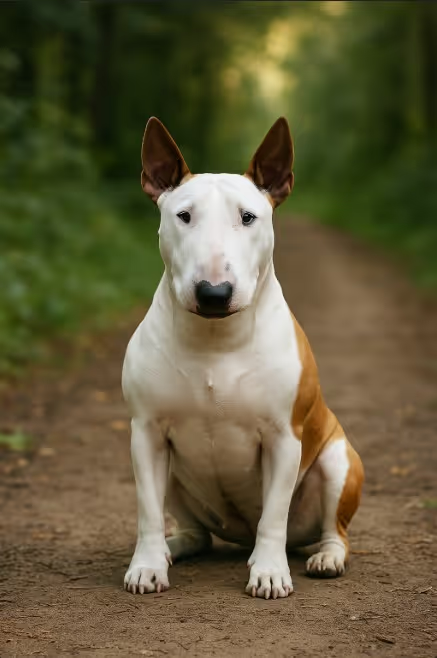The Bull Terrier is an athletic, egg-headed terrier famous for its strong build, triangular eyes, and playful, clownish charm. Affectionate and people-oriented, Bull Terriers thrive with active owners who provide clear rules, early socialization, and daily exercise. If you’re wondering “Are Bull Terriers good family dogs?”—yes, in structured, training-minded homes. “Do Bull Terriers shed?”—low to moderate. “Are Bull Terriers hypoallergenic?”—no. Expect enthusiasm, stubborn smarts, and big cuddles.

Developed in 19th-century England from bulldog and terrier crosses, the Bull Terrier was refined by James Hinks into a stylish, all-white companion and show dog, later expanded to colored varieties. The breed moved from rough work to gentleman’s companion—courageous, steady, and comical. Today Bull Terriers shine as active family dogs and sport partners when well socialized and trained.
A muscular, balanced terrier with a distinctive egg-shaped head and keen, triangular eyes.
Low-maintenance coat; watch skin, ears, and sun on light coats.
A bouncy, strengthy athlete—mix cardio with impulse control.
Smart, determined, and sensitive—keep training upbeat, clear, and consistent.
Feed for lean muscle and healthy skin.
Generally robust, with a few breed-linked issues—screening matters.
Choose health-tested, temperament-sound dogs—or consider rescue.
Are Bull Terriers good family dogs?
Yes—affectionate and fun with structured training, exercise, and supervision (they’re strong).
Do Bull Terriers shed?
Low to moderate. Weekly brushing controls hair; seasonal increases are normal.
Are Bull Terriers hypoallergenic?
No.
How much exercise does a Bull Terrier need?
Plan for 60–90 minutes daily plus brain work (obedience, nose games, puzzle toys).
Are Bull Terriers aggressive?
They’re not inherently aggressive, but they’re powerful and can be dog-selective—early socialization, management, and training are essential.
Bull Terrier vs Miniature Bull Terrier—what’s different?
Same look and attitude; Miniature is smaller (separate breed). Care and training needs are similar; check height/weight limits and health testing.
Do white Bull Terriers go deaf?
Some do—BAER testing is recommended for all puppies (especially whites) to confirm hearing.
Are Bull Terriers good apartment dogs?
Yes for active owners—meet exercise needs and provide training/enrichment to prevent boredom.
Do Bull Terriers have skin problems?
Skin allergies can occur—use gentle shampoos, manage diet, and work with your vet for flare control.